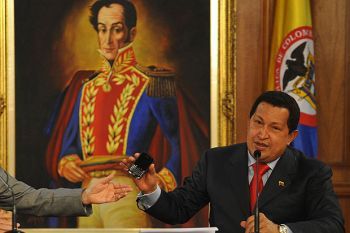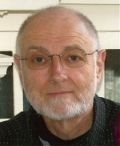
Publisher:
Bonnie King
CONTACT:
Newsroom@Salem-news.com
Advertising:
Adsales@Salem-news.com

~Truth~
~Justice~
~Peace~
TJP
Mar-12-2013 14:30

 TweetFollow @OregonNews
TweetFollow @OregonNews
Does Hugo Chavez's Death Mean The End Of His Bolivarian Revolution?
Salem-News.comI personally like the idea of a Latin American union similar to the European Union largely free from U.S. control.
 Hugo Chávez Under a Painting of Simón Bolivar |
(SAN FRANCISCO) - On March 5, 2013, Hugo Rafael Chávez Frias, the president of Venezuela, died of a massive heart attack and his cancer was very advanced when he died. Was his dream of a "Bolivarian Revolution" buried with him?
Chávez envisioned a modern day Bolivarian Revolution, a Latin American political block with a socialist bent as an alternative to U.S. hegemony. To this end, Chávez was generous with his foreign aid to Latin America and the Caribbean in an effort to blunt U.S.-backed economic policies in Latin America. His efforts garnered some support among the growing number of Latin America’s left-leaning governments.
Chávez often spoke under a portrait of "The Liberator," quoted his words frequently, and linked himself to this legendary figure to gain popular support for his programs both at home and abroad. Chávez also renamed Venezuela the Bolivarian Republic of Venezuela, and said he was creating a socialist system based on Bolivar's ideals.
However, Chávez spent so much time on the international stage that he neglected the problems on the home front such as government corruption, inefficiency, and mismanagement; the deteriorating health and education programs; the troubled economy; crime; human rights violations; and media censorship. And many Venezuelans feared that the “socialist revolutionary” was slowly morphing into a president-for-life. Just who is this Simón Bolivar anyway?
Simón Bolivar was born in Caracas, Venezuela in 1783. At age 16, he was sent abroad to continue his education in Spain and France where he was introduced to the progressive works of Rousseau and Voltaire. He married Spaniard Maria Teresa and returned to Venezuela. Maria Teresa died 8 months later of yellow fever. He never married again but had many lovers, including Manuela Saenz affectionately known as Manuleta, whom he met in 1822 and who was with him until a few days before he died. After Maria Teresa's death, he returned to France and met with the leaders of the French Revolution. Bolivar then traveled to the United States to witness the U.S. after the American Revolution. He returned to Caracas filled with revolutionary ideas and quickly joined pro-independence groups. Bolivar's military career began under Francisco de Miranda. When Miranda was captured by the Spanish in 1812, Bolivar took command.
Over the next decade, Bolivar commanded the independence forces in numerous battles, including the key battle of Carabobo, which brought independence for Venezuela. Bolivar also brought independence from Spanish rule to the entire northwest of South America, creating the Gran Colombia in what today comprises Venezuela, Colombia, Panama, Ecuador, Peru, and Bolivia. Because his central government could not govern such a large land mass with its racial and regional differences, his Gran Colombia lasted just a decade. Disillusioned and in bad health, Bolivar resigned the presidency of Gran Colombia in early 1830. He died in December 1830 at age 47, in Santa Marta, Colombia, while on his way to Europe. Ironically, the newly independent Venezuela banned Bolivar from his homeland for twelve years until 1842, when his remains were finally brought from Santa Marta to Caracas and entombed in the "catedral." In 1876, his remains were transferred to the "Panteon Nacional."
In 2007 and 2008, my wife and I traveled to Venezuela. (My wife Judi is Venezuelan and speaks Spanish fluently.) We were cautioned never to show disrespect for Bolivar. During our brief stays in Caracas, Venezuela's capital city, we did a mini-tour of Bolivariana, which began at the Plaza Bolivar. Every Venezuelan city has a Plaza Bolivar. The federal district (Caracas) and the capital cities of Venezuela's twenty-two states such as Merida, Coro, Barinas, Guanare -- capital cities we visited -- have a statue of Bolivar on a horse. Other major cities have a statue of Bolivar unhorsed and smaller towns have a bust of Bolivar in their Plaza Bolivar.
We visited Bolivar's birthplace ("Casa Natal de Bolivar"), the Bolivar museum ("Museo Bolivariana") next door where I was asked to remove my cap out of respect, the nearby cathedral where he was baptized and where his wife and family lie, and the "Panteon Nacional" containing his body -- until he was recently exhumed -- and those of other eminent Venezuelans.
In 2009, we took a road trip along the coast from Cartagena, Colombia, to visit Quinta de San Pedro Alejandrino, the hacienda where Bolivar spent his last days before he died. Spaniard Joaquin de Mier, the owner of the hacienda and a supporter of Colombia’s independence, invited Bolivar to stay and rest until his departure for Europe. The hacienda grounds contain a massive central structure ("Altar de la Patria"), the Museo Bolivariana, and a 22-hectare garden.
If Chávez had lived, would his "Bolivarian Revolution" have succeeded? We will never know. It is doubtful, however, that either Nicolás Maduro, Chávez's chosen successor, or Venezuelan opposition leader Henrique Capriles, have the charisma or international presence to pick up the baton and carry it to the finish line. But Chávez has planted the seed.
I personally like the idea of a Latin American union similar to the European Union largely free from U.S. control. For centuries the U.S. has carried the Monroe Doctrine to absurd extremes, treating Latin America as one big U.S. colony. I recommend Oliver Stone"s documentary, South of the Border. You know going in that it will be one-sided, but it is refreshing to see and hear Chávez, Lula da Silva (Brazil), Evo Morales (Bolivia), the Kirchners (Argentina), Fernando Lugo (Paraguay), Rafael Correa (Ecuador), and Raúl Castro speak unfiltered through the U.S. media. The film mostly focuses on Chávez.

Salem-News.com writer Ralph E. Stone was born in Massachusetts. He is a graduate of both Middlebury College and Suffolk Law School. We are very fortunate to have this writer's talents in this troubling world; Ralph has an eye for detail that others miss. As is the case with many Salem-News.com writers, Ralph is an American Veteran who served in war. Ralph served his nation after college as a U.S. Army officer during the Vietnam war. After Vietnam, he went on to have a career with the Federal Trade Commission as an Attorney specializing in Consumer and Antitrust Law. Over the years, Ralph has traveled extensively with his wife Judi, taking in data from all over the world, which today adds to his collective knowledge about extremely important subjects like the economy and taxation. You can send Ralph an email at this address stonere@earthlink.net
 |
 |
 |
Articles for March 11, 2013 | Articles for March 12, 2013 | Articles for March 13, 2013
Quick Links
DINING
Willamette UniversityGoudy Commons Cafe
Dine on the Queen
Willamette Queen Sternwheeler
MUST SEE SALEM
Oregon Capitol ToursCapitol History Gateway
Willamette River Ride
Willamette Queen Sternwheeler
Historic Home Tours:
Deepwood Museum
The Bush House
Gaiety Hollow Garden
AUCTIONS - APPRAISALS
Auction Masters & AppraisalsCONSTRUCTION SERVICES
Roofing and ContractingSheridan, Ore.
ONLINE SHOPPING
Special Occasion DressesAdvertise with Salem-News
Contact:AdSales@Salem-News.com

googlec507860f6901db00.html



Terms of Service | Privacy Policy
All comments and messages are approved by people and self promotional links or unacceptable comments are denied.
[Return to Top]
©2025 Salem-News.com. All opinions expressed in this article are those of the author and do not necessarily reflect those of Salem-News.com.